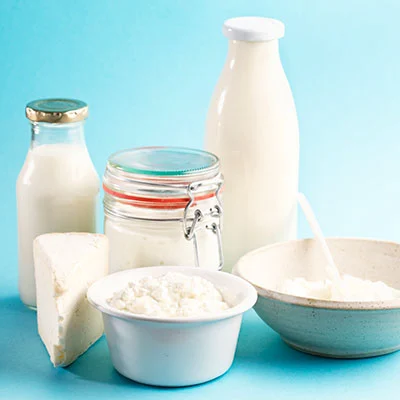Does Milk Have Sugar?
Yes, an 8-ounce glass of cow's milk naturally contains about 12 grams of sugar, primarily in the form of lactose, which is a natural milk sugar. However, flavored milk options, such as chocolate milk, typically contain additional added sugars to enhance their taste thus increasing the total sugar content.
Exactly How Much Sugar Is in a Glass of Milk?
Most plain cow's milk, whether nonfat (skim), low fat (1%), reduced-fat (2%), whole or lactose-free, naturally contains about 12 grams of sugar (lactose) in every 8-ounce glass. Flavored milks, like chocolate milk or the kinds served in school lunches, have around 24 grams of total sugar with about half coming from natural lactose and half from added sugars for extra sweetness. Want to see how it all compares? Take a look at the chart below!
|
Type of Milk |
Milk Sugar Content (per 8 oz. serving) |
|
12 grams natural sugar |
|
|
12 grams natural sugar |
|
|
12 grams natural sugar |
|
|
12 grams natural sugar |
|
|
24 grams sugar (12 grams natural sugar, 12 grams added sugar) |
|
|
24 grams sugar (12 grams natural sugar, 12 grams added sugar) |
|
|
12 grams natural sugar |
So Is the Natural Sugar in Milk Bad for You?
The sugar in milk, known as lactose, is not inherently bad for you. In fact, it provides a natural source of energy. When looking at your diet as a whole, it’s important to consider a food’s full nutrient package. Many foods with naturally occurring sugars, like milk or fruit, also offer nutritious vitamins, minerals, protein, fiber or bioactives that can benefit our health. So yes, while milk does have natural sugar, it also delivers 13 essential nutrients and 8 grams of high-quality protein in every 8-ounce glass. For most people, the benefits of milk outweigh any concerns about its natural sugar content.
How Do I Know if the Sugar is Natural or Added?
If you want to know if the sugar in milk is natural or added, take a look at the nutrition facts label on your milk carton. It will show both total sugars (which includes the natural sugar) and added sugars. Added sugars are used to add flavor or enhance sweetness and should be limited to under 50 grams per day for most adults.
Choosing the Right Milk for Diabetics
When selecting milk for a diabetic-friendly diet, it's important to consider the sugar content and how it fits into your overall carbohydrate intake. While regular cow's milk contains about 12 grams of natural sugar per 8-ounce serving, flavored milk options can significantly increase the sugar count. For those who prefer cow's milk, choosing low-fat or fat-free varieties may help manage blood sugar and support heart health. When choosing dairy products with type 2 diabetes, always be sure to check the nutrition label for added sugars and portion sizes to keep your blood sugar levels stable.
What About The Sugar in Lactose-Free Milk?
Lactose-free milk contains the same amount of natural sugar as regular milk. The key difference is that the lactose, the sugar that some people with lactose intolerance have difficulty digesting, has been broken down into simpler sugars like glucose and galactose. This makes it easier for those with lactose intolernace to digest without experiencing discomfort. Despite this, lactose-free milk still provides the same natural sugars and essential nutrients as regular milk.
Have more questions on milk sugar content? You can find answers here.















